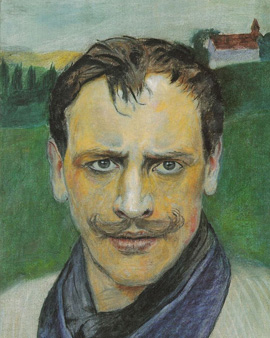From childhood on, Harald Oskar Sohlberg had the desire to become an artist. But his father, a fur trader, insisted that his eleven children, especially the sons, "study something clever. But since the young Harald was not particularly attentive or successful in class and ended his school career early, the only thing left for him was a solid education in the trades. And so, at the age of 16, he began an apprenticeship as a decorative painter. Then Harald Oskar Sohlberg was helped by chance, or rather by a family friend. He recognized the artistic talent of the now 20-year-old and recommended to his strict father that he allow his son to study at the Royal Drawing School in Christiania (today: Oslo). Thus it came that he studied painting after all with Harriet Backer, Kristian Zahrtmann Erik Werenskiold and Eilif Peterssen. They were all known for a Nordic aesthetic rich in strong colors, light and shadow. However, Sohlberg was not only influenced by his teachers, but also by studying the works of Paul Gauguin and other symbolists.
Sohlberg had his first breakthrough as an artist at the "Oslo State Exhibition", where he showed one of his landscape paintings. The painting was purchased by the Norwegian National Gallery. It was a remarkable success, which not only earned him a scholarship in Paris, but also aroused the interest of the art collector and patron Olaf Schou. With his financial support, Sohlberg traveled to the mountains around Rondane, which were to leave a lasting impression on him. He captured the wild beauty of the rugged landscape in numerous studies and watercolors. Years later, these impressions then flowed into his neo-Romantic landscape paintings.
At the beginning of the 20th century, Harald Oskar Sohlberg lived with his wife Lili in a small mining town called Røros. The surroundings, characterized by smelters and industrialization, would not exactly be called picturesque or inspiring today. But for the artist, the years in Røros were to be among the most productive times of his life. In particular, he captured everyday street scenes, with an incredible attention to detail - whether they were cobblestones or telegraph poles. There was only one thing his pictures rarely showed: People. Rather, the artist was interested in addressing their absence.
Harald Oskar Sohlberg rejected throughout his life the claim that he was under the influence of Edvard Munch, who was only six years older than him. Of course, there are certain similarities, but these are on the whole typical of early 20th century Nordic art - from the color palette to the choice of motifs, from symbolism to mysticism. Moreover, Sohlberg's paintings lack the psychological component inherent in Edvard Munchs work. In exchange, Sohlberg's pantheistic views are characterized by a warmth that, in turn, Munch's works lack. Sohlberg was not only a painter, however, but also a graphic artist. His graphic work was an important additional source of income. The artist died of cancer at the age of 65. To mark his 150th birthday, Norway Post issued a Sohlberg special stamp in 2019.
×





.jpg)
.jpg)
.jpg)
.jpg)
.jpg)
.jpg)
.jpg)
.jpg)
.jpg)
.jpg)
.jpg)
.jpg)
.jpg)
.jpg)
_-_(MeisterDrucke-1323790).jpg)
_-_(MeisterDrucke-1323790).jpg)
.jpg)
.jpg)
.jpg)
.jpg)
.jpg)
.jpg)
.jpg)
.jpg)
.jpg)
.jpg)
.jpg)
.jpg)
.jpg)
.jpg)
.jpg)
.jpg)
_-_(MeisterDrucke-1313069).jpg)
_-_(MeisterDrucke-1313069).jpg)
.jpg)
.jpg)
.jpg)
.jpg)
.jpg)
.jpg)
.jpg)
.jpg)
.jpg)
.jpg)
.jpg)
.jpg)
.jpg)
.jpg)
.jpg)
.jpg)
.jpg)
.jpg)
.jpg)
.jpg)
.jpg)
.jpg)
.jpg)
.jpg)
.jpg)
.jpg)
.jpg)
.jpg)
.jpg)
.jpg)
.jpg)
.jpg)
.jpg)
.jpg)
_-_(MeisterDrucke-1322062).jpg)
_-_(MeisterDrucke-1322062).jpg)
.jpg)
.jpg)
.jpg)
.jpg)
.jpg)
.jpg)
_-_(MeisterDrucke-1322556).jpg)
_-_(MeisterDrucke-1322556).jpg)
.jpg)
.jpg)
_-_(MeisterDrucke-1319100).jpg)
_-_(MeisterDrucke-1319100).jpg)
.jpg)
.jpg)
.jpg)
.jpg)
_-_(MeisterDrucke-1324419).jpg)
_-_(MeisterDrucke-1324419).jpg)
.jpg)
.jpg)
.jpg)
.jpg)
.jpg)
.jpg)
.jpg)
.jpg)
.jpg)
.jpg)
.jpg)
.jpg)
.jpg)
.jpg)
.jpg)
.jpg)
.jpg)
.jpg)
.jpg)
.jpg)
.jpg)
.jpg)
.jpg)
.jpg)
.jpg)
.jpg)
_-_(MeisterDrucke-1319777).jpg)
_-_(MeisterDrucke-1319777).jpg)
.jpg)
.jpg)
.jpg)
.jpg)
.jpg)
.jpg)
.jpg)
.jpg)
.jpg)
.jpg)
.jpg)
.jpg)
.jpg)
.jpg)
.jpg)
.jpg)
.jpg)
.jpg)
.jpg)
.jpg)
_-_(MeisterDrucke-1317530).jpg)
_-_(MeisterDrucke-1317530).jpg)
.jpg)
.jpg)
_-_(MeisterDrucke-1326080).jpg)
_-_(MeisterDrucke-1326080).jpg)
.jpg)
.jpg)
.jpg)
.jpg)
.jpg)
.jpg)
.jpg)
.jpg)
.jpg)
.jpg)
_1894_(oil_on_canvas)_-_(MeisterDrucke-1314160).jpg)
_1894_(oil_on_canvas)_-_(MeisterDrucke-1314160).jpg)
.jpg)
.jpg)
.jpg)
.jpg)
.jpg)
.jpg)
.jpg)
.jpg)
.jpg)
.jpg)
.jpg)
.jpg)
.jpg)
.jpg)
.jpg)
.jpg)
.jpg)
.jpg)
_-_(MeisterDrucke-1326012).jpg)
_-_(MeisterDrucke-1326012).jpg)
.jpg)
.jpg)
.jpg)
.jpg)






